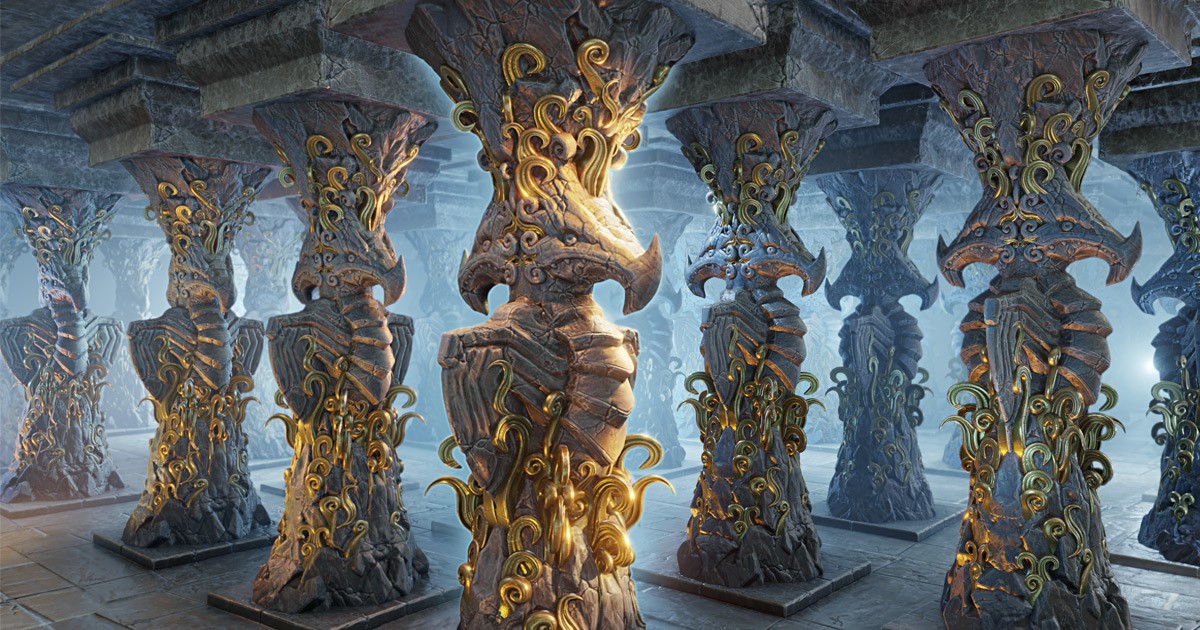You are using an out of date browser. It may not display this or other websites correctly.
You should upgrade or use an alternative browser.
You should upgrade or use an alternative browser.
Modern and Future Geometry Rasterizer layout? *spawn*
- Thread starter Digidi
- Start date
Nanite doesn't do any ray tracing against polygons, but I'm quite certain they do trace against other surface representations. (Ray,cone or sphere against voxel/distance field.)
There are ways to get same effect with rasterization..
Although it would become quite messy..wouldn't it? (Something like depth peeled splatting of distance fields and voxels?)
They also have some form of feedback loop to get the 'infinite' bounces happening.
There are ways to get same effect with rasterization..
Although it would become quite messy..wouldn't it? (Something like depth peeled splatting of distance fields and voxels?)
They also have some form of feedback loop to get the 'infinite' bounces happening.
Last edited:
A funny moment i captured, was at the PS5 event. Marc Cerny is saying that higy plygon count will result in less power consumption than when you use simple polygon models.
For example he is mentioning Horizon Zero Dawn which have low polycount maps, but it is consuming a lot of power.
Also if you look at the layout of the PS5 with high clock speed but less shader they are going indeed to high polygon model?
For example he is mentioning Horizon Zero Dawn which have low polycount maps, but it is consuming a lot of power.
Also if you look at the layout of the PS5 with high clock speed but less shader they are going indeed to high polygon model?
Last edited:
I was intresting about these sentence from Mark Cerny in the Video:
"But power isn't simply about engine quality it's about the minutiae of what's being displayed and how. its counterintuitive but processing dense geometry typically consumes less power than processing simple geometry which is I suspect why horizons map screen with its low triangle count makes my ps5 pro heat up so much."
I was intresting about these sentence from Mark Cerny in the Video:
What are the chances that Simple Geometry (especially in the case of a map screen or menu screen) would cause really high framerates and therefore increase power usage?
As polygon size goes down, so does GPU utilization.I was intresting about these sentence from Mark Cerny in the Video:
There is limit how many triangles can be rasterized or rendered at same time and how many pixels must be in flight for all units get work.
It's quite common problem in games when v-sync is not enabled.What are the chances that Simple Geometry (especially in the case of a map screen or menu screen) would cause really high framerates and therefore increase power usage?
Always fun to have fps counter on and see few thousands of fps and hear fans pick up the pace.
Her is a Patent for Micropolygon Rasterizer, so if the Poylgon is smaller than a Pixel it will be handeld to a special Rasterizer?
https://www.freepatentsonline.com/y2018/0061124.html
https://www.freepatentsonline.com/y2018/0061124.html
The proposal seems to give the possibility for there being multiple size thresholds, and assigning primitives to a rasterizer dedicated to that size range. A quad seems to be one particular size of interest.
It's from 2016, though I haven't seen mention of it being used.
It's from 2016, though I haven't seen mention of it being used.
When i see nanite enigne i think the real bottelnack are micro polyogons. I wathched these analysis of nanite egninge an also looked clother. Even whene there is no good lightning in the scene the polygon structure make it unike. I don't understand why whe invest so much in shader when micro polygons gif you so much picture quality:
I'm confused. At 3:40 the guy from Epic introduces Lumen with talking about RTX. But it does not become really clear if they use it or not.
I assumed for sure that Lumen was confirmed to not use RTX.
Did i get this wrong?
It doesn't use "RTX". RTX isn't acronym for raytracing.I'm confused. At 3:40 the guy from Epic introduces Lumen with talking about RTX. But it does not become really clear if they use it or not.
I assumed for sure that Lumen was confirmed to not use RTX.
Did i get this wrong?
Lumen uses software raytracing for indirect lighting
https://www.eurogamer.net/articles/...eal-engine-5-playstation-5-tech-demo-analysis"Lumen uses ray tracing to solve indirect lighting, but not triangle ray tracing," explains Daniel Wright, technical director of graphics at Epic. "Lumen traces rays against a scene representation consisting of signed distance fields, voxels and height fields. As a result, it requires no special ray tracing hardware."
I want to bring back this discussion. I wonder which new features the 4090 and 7900xtx have for geometry output. And what are the current state of primitive and mesh shaders. Anybody has an idea and can make a summery where we are?
Maybe helpful Links:

 blog.siggraph.org
blog.siggraph.org

 disruptiveludens-wordpress-com.translate.goog
disruptiveludens-wordpress-com.translate.goog
Maybe helpful Links:
How mesh shaders are implemented in an AMD driver
In the previous post I gave a brief introduction on what mesh and task shaders are from the perspective of application developers. Now it’s time to dive deeper and talk about how mesh shaders are implemented in a Vulkan driver on AMD HW. Note that everything I discuss here is based on my...
timur.hu

Mesh Shaders Release the Intrinsic Power of a GPU - ACM SIGGRAPH Blog
Jon Peddie Research shares how it has taken 20 years to realize the intrinsic power of a GPU through mesh shaders.

Primitive vs Mesh Shader, aclarando la confusión
El mayor cuello de botella que han tenido las GPU en todos estos años ha sido la etapa de rasterizado, donde es completamente igual la capacidad de cálculo de toda la geometría previa, que si la un…
Someone wants to benchmark on 4090.
 tellusim.com
tellusim.com
Mesh Shader versus MultiDrawIndirect - Tellusim Technologies Inc.
Tellusim Technologies Inc. Mesh Shader versus MultiDrawIndirect
 tellusim.com
tellusim.com
Someone wants to benchmark on 4090.
Mesh Shader versus MultiDrawIndirect - Tellusim Technologies Inc.
Tellusim Technologies Inc. Mesh Shader versus MultiDrawIndirecttellusim.com
MDI: 22.5B
MS: 55B
(in D3D12)
Maybe I'm stupid (I am) but I couldn't get the D3D12 path to work. It would just open and close instantly.MDI: 22.5B
MS: 55B
(in D3D12)
this was when the first PS5 model launched, right? I remember a DF article mentioning that the power consumption of the PS5 was 220W, which I found too high. Did that number change in the recent revisions? It's not justified nowadays. Judging from the new GPUs I've seen the PS5 should be around 140-160W at most.A funny moment i captured, was at the PS5 event. Marc Cerny is saying that higy plygon count will result in less power consumption than when you use simple polygon models.
For example he is mentioning Horizon Zero Dawn which have low polycount maps, but it is consuming a lot of power.
Also if you look at the layout of the PS5 with high clock speed but less shader they are going indeed to high polygon model?
davis.anthony
Veteran
this was when the first PS5 model launched, right? I remember a DF article mentioning that the power consumption of the PS5 was 220W, which I found too high. Did that number change in the recent revisions? It's not justified nowadays. Judging from the new GPUs I've seen the PS5 should be around 140-160W at most.
The new versions use 20-30w less than the launch model.
There were also interesting links to other aspects inside the files:
 tellusim.com
tellusim.com
 tellusim.com
tellusim.com
 tellusim.com
tellusim.com
 tellusim.com
tellusim.com
Anybody can do the normal vertex shader benchmark on a 4090?
Here are same vlaues from Basix for the 4090. Thank you @basix for the Test
 www.forum-3dcenter.org
www.forum-3dcenter.org
Mesh Shader Emulation - Tellusim Technologies Inc.
Tellusim Technologies Inc. Mesh Shader Emulation
 tellusim.com
tellusim.com
Mesh Shader Performance - Tellusim Technologies Inc.
Tellusim Technologies Inc. Mesh Shader Performance
 tellusim.com
tellusim.com
Mesh Shader versus MultiDrawIndirect - Tellusim Technologies Inc.
Tellusim Technologies Inc. Mesh Shader versus MultiDrawIndirect
 tellusim.com
tellusim.com
Compute versus Hardware - Tellusim Technologies Inc.
Tellusim Technologies Inc. Compute versus Hardware
 tellusim.com
tellusim.com
Anybody can do the normal vertex shader benchmark on a 4090?
Here are same vlaues from Basix for the 4090. Thank you @basix for the Test
3DCenter Forum - nVidia - GeForce RTX 4090 Review-Thread - Seite 116
nVidia - GeForce RTX 4090 Review-Thread Grafikchips und Grafikkarten
Also i'm wondering. When you use compute shader for primitives, Is this value not misleading? If you use compute Shader mybe shader also occupied by other stuff like lighning. Maybe then the advantage of compute shader would be a disatvantage in real world test?RTX 4090 @ 2.55 GHz // 5800X3D:
Mesh Instance Tris: 16.52 B/S
Mesh Primitive 64x84: 8.78 B/s
Mesh Indexing: 64x84: 9.56 B/s
Mult DrawIndirext 64x84: 14.53 B/s
Mesh Shader: 22.64 B/s (144fps Limit?) // 33.47 B/s (anotther window "aktiv")
Compute Shader: 22.64 B/s (144fps Limit?) // 88.3 B/s (anotther window "aktiv")
Interessant:
With 2.72 GHz i get 10.5 B/s Mesh Primitive (+19.6%) and 10.9 B/s Mesh Indexing (+14%). We see here maybe the reduce of voltage and the reducinge of internel domain clocks. With compute shader it is scaling with the clock perfectly.
Sorry for my bad translation.
Last edited:
Here is also a good benchmark tool for geometry. Maybe sombody will try if can render the 4.000.000 astrorides with mesh and with compute shaders? My GPU will not start becasu it is to much for it XD
If you want to increase the polyogns use LOD Bias 6 Also don't close the small message which pops up other wise you can not run the benchmark.
Also don't close the small message which pops up other wise you can not run the benchmark.
Short Info. The Test is not running on Vulcan when you select Sensor and Info at my computer.


If you want to increase the polyogns use LOD Bias 6
Short Info. The Test is not running on Vulcan when you select Sensor and Info at my computer.


Last edited:
Similar threads
- Replies
- 2
- Views
- 3K
- Replies
- 21
- Views
- 2K
- Replies
- 22
- Views
- 2K
D
- Replies
- 5
- Views
- 4K
- Replies
- 21
- Views
- 3K

